Neil Peart's News, Weather and Sports
Every Road Has Its Toll
NeilPeart.net, August 2007
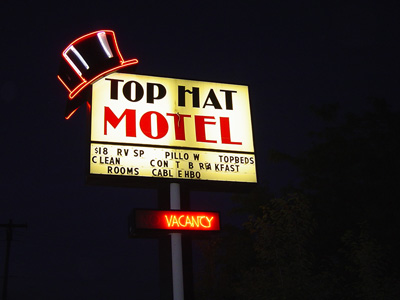
Standing backstage while the opening movie played the other night, poised to run on, sticks in hand, ear-monitors in, I found myself excited by two thoughts. I was idly pondering how I might start my solo that night (since I have been improvising the first part of it this tour, I always try to open with a different figure straight off), and I also felt an unaccustomed eagerness - a curiosity to get out there to see the audience.
Not to hear the audience, note - not to bask in their cheers and appreciation - but just to look at them. Their numbers, their faces, their reactions, their dances, their T-shirts, the signs they hold up. Even while I'm supposed to be up there entertaining people, they can be so entertaining for me.
Occasionally signs are scattered among the crowd, like two I saw in the audience at Red Rocks: One quite far back on the stage-right side read, "If I Loved a Woman Like I Love This Band, I'd Still Be Married!" Near the front, on the stage-left side, was another, "I Support My Husband's Rush Addiction!" Two very different stories there, obviously.
One night in Texas I saw a truly great sign from far back in the house, "VBS Field Trip." It was a sly reference to a joke in my previous story on this site (glad to know some people get my lame jokes!). At intermission, Michael and I laughed about that one, and its maker was unanimously declared the night's lucky winner of a pair of drumsticks. That doesn't happen every night, you understand - let's not make this some kind of competition - but some nights, a sign or a T-shirt slogan makes me smile, or I see a cute little kid, or sometimes recognize a familiar face from many shows, and send them out a pair of sticks.
One night on the first run I was won over by a professional-looking sign along the barricade that read, "My 60th Show and Still No Drumsticks. I'm Just Saying ..."
The phrasing alone was irresistible, and Geddy said later that if I hadn't sent the guy out a pair of sticks, he was going to ask his tech, Russ, to get some from Gump and send them out.
One offer, "Will Trade Macallan for 747s" seemed promising, but I doubted anyone had managed to bring a bottle of whisky into the venue. Following our plan, Michael took a pair of sticks out, but asked for the Macallan first. When the guy said he hadn't been able to bring it in, but it was in his car, Michael pretended to turn away - then gave him the sticks.
A few of the signs with requests are inspired in some such fashion, but a scrap of paper scrawled with "Stick?" does not impress so much (though, to be fair, I do appreciate any amount of trouble people go to), nor the one I saw the other night, "Spare Styx?"
At intermission, I told Michael about it, and asked if maybe we could send the sign-holder Michael's beloved 8-track of The Grand Illusion. He said no, because all those childhood favorites were on his iPod now.
Ba-da-boom.
But seriously, folks ... I can report that the Snakes and Arrows tour continues to go pretty well. The audiences have been wonderfully large and unbelievably appreciative (adjectives interchangeable), and the shows themselves have been going smoothly for us and our crew.
But ... just now counting up what we've done, and what we still have to do, I must admit to feeling a little apprehension at the realization that we are only now at the halfway point of the tour. We've done thirty-two shows, and have exactly that many to go. It seems a lot - in both directions.
Getting to those first thirty-two shows, Michael and I have already ridden 13,211 motorcycles miles. At that rate, we'll likely top last tour's total of 21,000 - especially by the time Brutus comes into the picture, in Europe, with his mad route-planning. (Though whether he and I will be able to ride to the last few shows, Oslo, Stockholm, and Helsinki, in late October, will depend on a selfish good fortune with climate change. We ought to increase our carbon footprint right away. Maybe by riding faster ... )
I spent a lot of time and energy on the R30 tour in 2004 taking notes, mental and written, trying to record each day's events, then researching and writing about it so copiously. Thus, this time I have been powerfully aware of how different this tour is from that one - as they all are from each other, I realize. No two tours are alike, just as no two shows are alike - and certainly no two audiences. In each case, there are many similarities, but so many variables and daily occurrences remain unique.
After all the ink I spilled about "magic shows" in Roadshow, it is strange to report that this tour has been different in that way, too. I don't think there have been any particularly "magic" shows, in my estimation - though they've all been pretty satisfying in their own ways. My best theory is that each of this tour's shows has been performed at a slightly higher level than ever before, and thus they've all had their bit of magic.
The explanation for that may be partly due to how well prepared we were - how much rehearsing we did before the tour - and to a pleasing variety of songs in the two sets, but it does seem that we have all reached a certain plateau of consistency and competency that is really shining on this tour. As I wrote about my own playing in that context, "Call it maturity."
Many friends have commented to me how well Geddy is singing, and it's true - I've listened to a few recorded shows on days off, and his voice sounds unbelievably good. (It's a simple stark fact illuminating the importance of that voice that if he couldn't do it anymore, we couldn't do it anymore.) Plus, as I said to Geddy after listening to one of the shows, "You're not just performing - you're really singing out."
Still, performing at that level takes its toll on Geddy, for he has to treat his voice with such care, even avoiding talking on days off, and warming it up methodically before a show. Likewise, performing at that level, and for so long (both in the number of hours in the show, and the number of years we've been doing it), takes its toll on us all. The other night Alex was telling me that even the knuckles on his fretting hand were sore after two shows in a row.
The drumming part of my touring life is certainly athletic, though few athletes are expected to surpass their peak at 54 years of age. I sure don't take it for granted that I have felt able to do that - I'm very gratified. But ... it takes its toll.
Taking into consideration that Michael's and my motorcycle rides between shows average about 275 miles a day, I actually spend far more time in the saddle than I do on the drum throne. That takes its toll, too - in the sore spots that Michael and I call "saddle tats;" in the tired mind from making a million decisions about traffic and road surfaces as you ride hour after hour; and in a body beaten by wind, vibration, and the physical activity of motorcycling, especially in the mountains, with so much braking, shifting, accelerating, and moving your body on the bike for more effective cornering.
Then there was the heat - in the 100s for many days, especially in the Southwest. Desert heat is one thing, but when the humidity is also high, as in South Texas, and you're wearing the armored suit, helmet, gloves, and boots, you get to feel like you're covered in a coat of slime, riding past a small-town bank clock showing 105°.
We have seen some fantastically scenic parts of the country, though. This western swing carried us through the Rockies, the Cascades, the Sierra Nevada, Northern and Southern California, the Great Basin, a broad swath of northern Arizona, across Colorado (or "Cop-orado," as I have christened the state, for its over-zealous enforcement of artificially low speed limits), and some of Texas's prettiest landscapes, the Hill Country and Gulf Coast.
Michael and I spent a very enjoyable couple of days crossing the wonderfully wide open spaces of Nevada. We sped down long, straight stretches of empty road, both paved and dirt, across the Great Basin of sage, juniper, stunted pines, and occasional twisty bits through the mountains - classic basin and range country. In South Texas we saw the ravages of the flooding from earlier this summer, with scoured riverbeds and rebuilt bridges and runoff areas that had been swept away.
(I am glad to report that rural Texas continues to boast the most courteous drivers in the country, perhaps the world. When you come up behind a pickup or sedan on a two-lane backroad, they not only move over willingly, right onto the shoulder, but wave you by cheerfully.)
We had a few more guest riders on the West Coast run, too, sometimes filling in for Michael when other duties called him away. John Wesley rode through Northern California with me, all the way down to the Hollywood Bowl (sorry about the ticket, Wes - and the hellish traffic around Lake Tahoe); Greg Russell (designer of this Web site, maker of the film, Swingin' Serpents, behind this tour's drum solo, and, in general, self-described "Master of All Things Creative") rode with Michael and me from Yuma, Arizona, up to old Route 66 and a classic motel in Seligman, Arizona.
Seligman clings to a tenuous existence on the tourist trade that haunts that old road, but there are so many small towns across America that are still dying - not so much because of being bypassed by interstates these days, as the old Route 66 towns were, but because of being bypassed by people. The decline of these small towns, sadly, is measured in the death of dreams - every time I see a shuttered restaurant, a boarded-up gas station, or an abandoned Main Street store, I imagine it is someone's dream that failed. Someone who always dreamed of having their own restaurant, their own gas station, their own little shop. Thus it always feels good to stop at a small-town diner, or stay at a Mom-and-Pop motel. Keep those dreams alive.
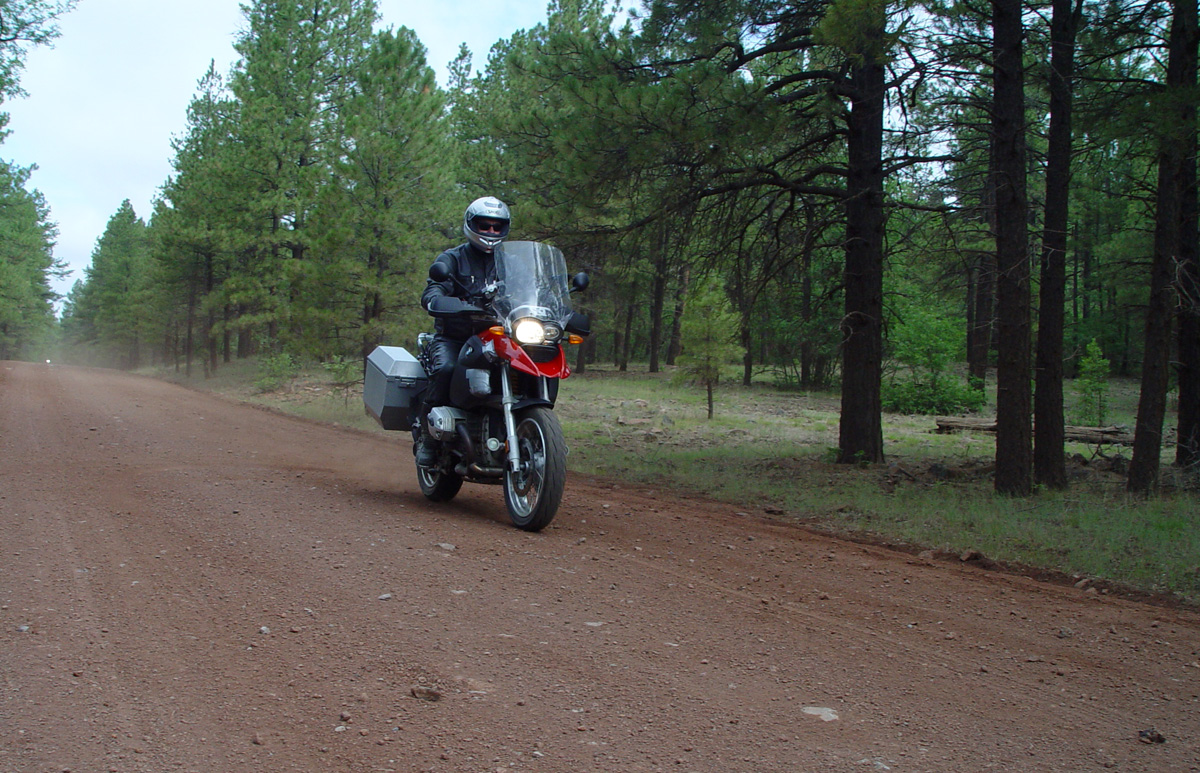
Leaving Seligman on our way to the next show in Phoenix, I had planned a route through the pine forests southeast of Flagstaff, on some red dirt back roads to Mormon Lake, then two-lane highways bracketed in woods that swung down through Payson, Pine, and Strawberry.
I had ridden and enjoyed those roads a few times before, but this time I added one new detour - to Roosevelt Dam. Having long been fascinated by the great waterworks of the West, I had visited many of the biggest ones, like Hoover, Grand Coulee, and Bonneville, so I thought I'd like to see the one that was built 100 years ago to feed Phoenix's growth, damming the Salt River for power and irrigation.
The temperature climbed all day, as we descended in elevation toward Phoenix, and the Tonto National Forest gave way to the rugged Superstition Mountains, folds of igneous rock lightly flecked in cactus desert. The blue expanse of the the reservoir, Theodore Roosevelt Lake, looked cool and inviting. The bridge over it - apparently the longest two-lane, single-span, steel-arch bridge in North America - echoed the attractive arc of the world's largest masonry dam (originally made of bricks, then later expanded with concrete).
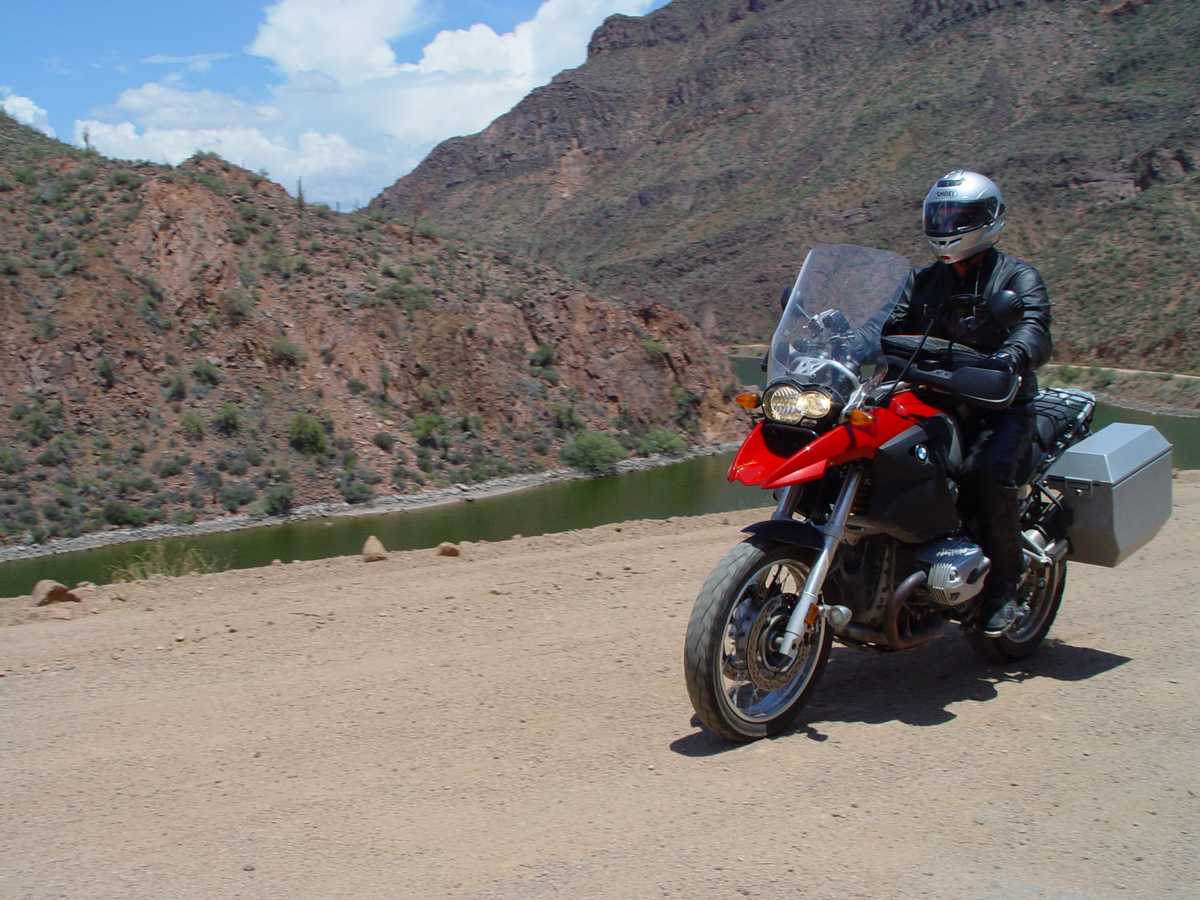
Taking in all of that world-class "largestness," we rode on, passing a sign informing us that the next twenty-eight miles of the Apache Trail were unpaved. The narrow gravel road twisted along the canyon of the winding Salt River, past cactus and desert shrubs clinging to the carved banks of rock, shimmering in the heat.
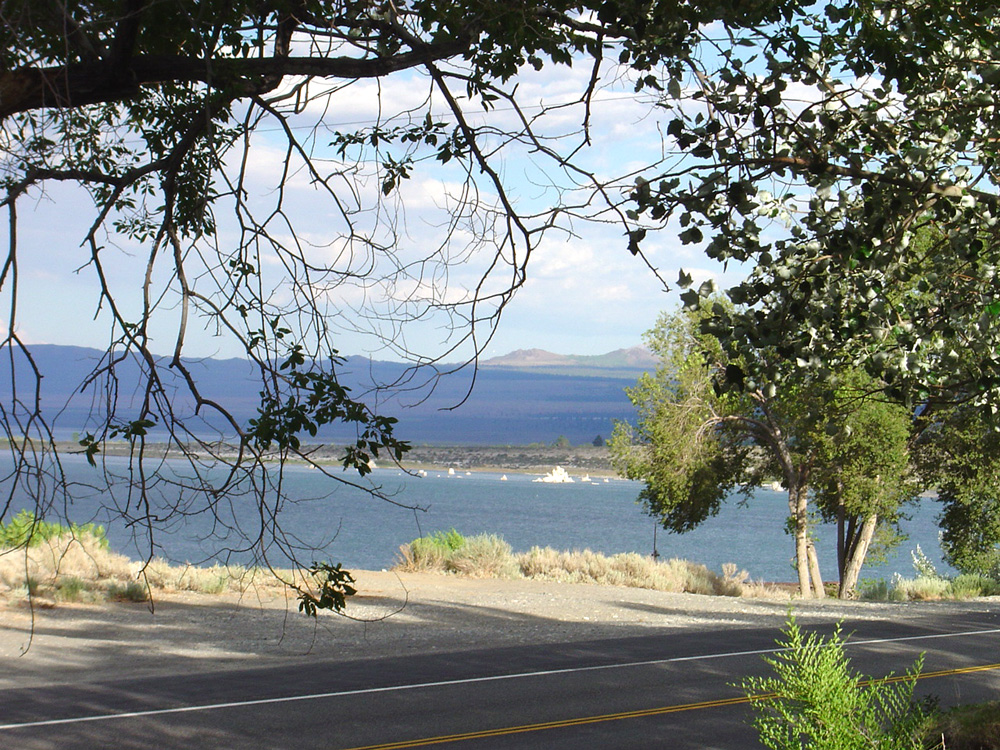
Michael, Greg, and I had some thrills scrambling in the dirt, then the pavement began for another twenty miles, still with very few other vehicles, and still winding as it led downriver to Apache Junction. The pavement was nicely banked, the tight curves taken in second gear and sometimes first, and altogether it was about my favorite kind of riding, technical, engaging, and exciting, at a slow enough speed that I dared to lean way over, and use all of those tires. The Apache Trail definitely ranks in my handful of favorite roads so far this tour. (Among the other candidates would be a couple of nameless tracks in West Virginia; Highway 129 in North Carolina, on the way to Deals Gap; a series of Washington state backroads from the Columbia River Valley to the Cascades; and the Sherman Pass in California, crossing the Sierras on the way to one of my favorite overnights, at Mono Lake.)
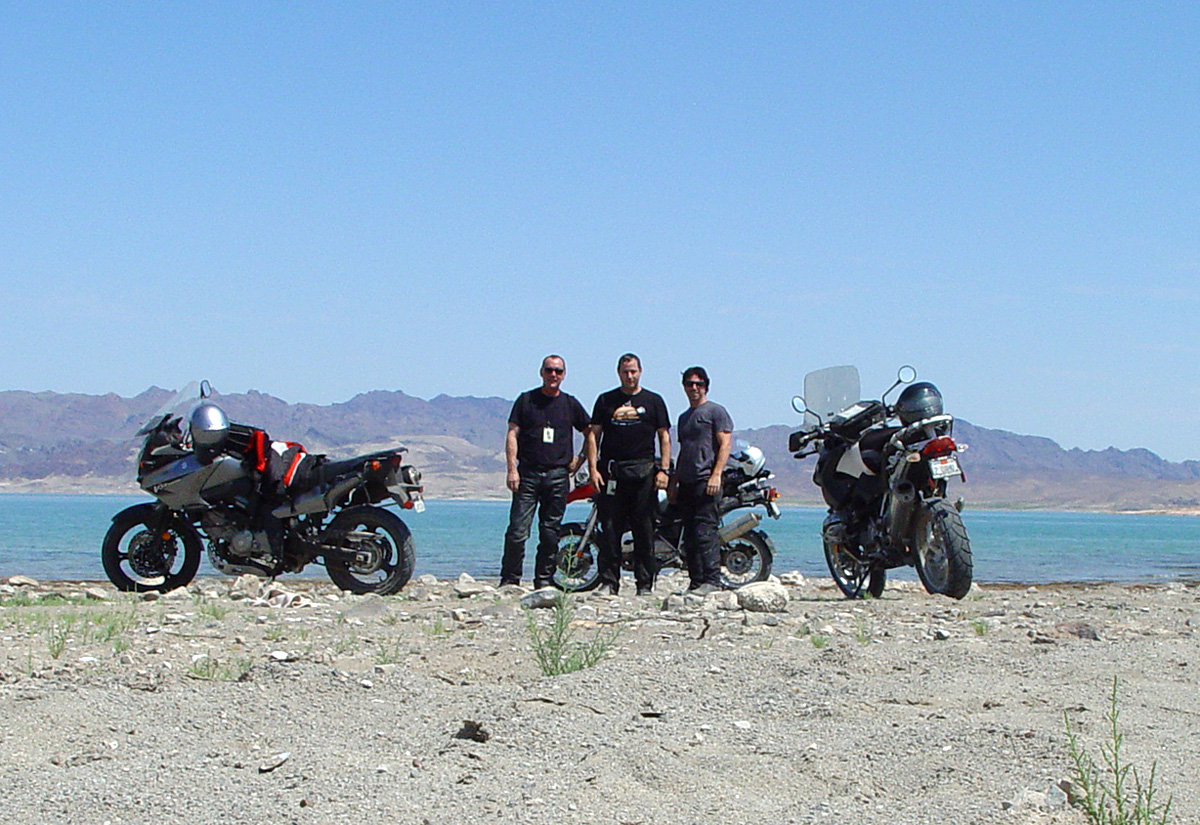
After the Phoenix show, Greg rode with us on the bus to a truck stop in Kingman, and next morning we set out for the MGM Grand in Vegas (where it was fiercely hot, 107°, but still nothing like as uncomfortable as that South Texas swelter). Once again, I had planned an adventurous detour, on a dirt road ending at a remote shore of Lake Mead.
Brian Catterson, editor-in-chief of Motorcyclist magazine, accompanied me across "Coporado." After the Salt Lake City show, we slept on the bus at a rest stop in Wyoming, then rode down the east side of Flaming Gorge. I had ridden the west side a couple of times, but Brian's brother Paul had recommended this route, and it proved to be a terrific series of linked, high-speed sweepers among majestic scenery.
Later that day, in the rangeland of western Colorado, Brian and I were caught in a violent thunderstorm. Lightning slashed down ahead to our right and left, and heavy rain was driven by crosswinds that swept spray across the road like ... spindrift. Marble-sized hail began pelting us, painful even through our armored suits, and about then I considered it the worst storm I had ever ridden through. But in that remote, treeless area, there was nowhere to take shelter, and nowhere to go back to. I was leading at the time, and felt responsible for us both, but I could think of nothing better to do than slow down and keep moving. Like the Winston Churchill quote, "When you're going through hell, keep going."
I was relieved to learn later that Brian had the same instinct, under the circumstances. Slow down, keep riding, and hope our "angels" were on duty. Still, we both knew that lightning had the lethal potential to "charge" a heavy toll to a motorcyclist. Later we talked about the rider who had been killed by lightning on a Cycle World tour while Brian worked there, and I was pleased to hear what Brian told me the guy's widow had said: "If he was struck by lightning when he was riding his motorcycle - it was his time."
That's easier to take than the cliché, "Well, at least he died doing what he loved."
Think about it: that's the last time anyone wants to die - when they're doing something they love!
After an overnight in the ski-boom town of Steamboat Springs (construction everywhere, but great restaurants), Brian and I joined the incredibly scenic (but painfully slow) parade through Rocky Mountain National Park. (This tour I have been pleased to add two new national park passport stamps to my collection, that one and Great Basin National Park in Nevada - hard to get to, but well worth a longer visit sometime.) Then we headed south on gently winding mountain roads that would have been posted at 55 mph in other states, but were "mysteriously" pegged at 40 around there. Perhaps it had nothing to do with "entrapment," or revenue generating, but I also couldn't help noticing that my radar detector was blipping in my ear every few minutes, as patrol cars rode the range, or hid in the trees.
Brian and I made it to Red Rocks unmolested by predatory patrol cars, but by the time Michael met us on his bike at the gate and led us into that fabulous venue, my nerves were even more on edge. Michael had traveled to Denver early to arrange for extra security for me there, because a schizophrenic "fan" was making insane accusations, and threatening me with violent consequences.
Just another day at the office ...
This issue's "Sports" report would also have to include deer hunting. Not intentional, alas, but an unfortunate encounter on a Texas road ended badly for a deer - and could so easily have ended badly for me. After sleeping on the bus in a truck stop in Junction, Texas, Michael and I set out early one Sunday morning through an area of the southern Hill Country I'd never explored. It began wonderfully, on a narrow, curving roller-coaster of a road walled by low, thick forests of Texas live-oak trees and high limestone banks. In their shade, while the sun was still low, the hazy morning felt relatively cool (though it was indeed relative - the temperatures were already climbing from the upper 80s toward the 100s. But it was shady, and that is rare enough in the Desert Southwest).
Apparently the Hill Country has the highest concentration of whitetail deer in the United States, and they were certainly plentiful that morning, grazing among the dense trees, bounding across the road, or just standing in the middle of it. So we kept our speed down. Only last year, motorcycle journalist Lawrence Grodsky, who wrote a column for Rider magazine called "Stayin' Safe," from which I learned a lot in my early years of riding, was killed by hitting a deer just west of where we were, near Fort Stockton.
Grodsky's girlfriend was quoted in an obituary in his hometown newspaper, the Pittsburgh Post-Gazette: "Larry was the most talented, experienced and competent motorcyclist in the country, but this is the one thing he knew he couldn't do anything about," said his girlfriend, Maryann Puglisi, with whom he lived in Squirrel Hill and Washington, D.C., and who helped run his business. "Just a few weeks ago he said to me, 'That's how I'm going to go, it's going to be a deer.' He could deal with all the idiot drivers, but at night when a deer jumps in your path, that's it and he knew that."
So that was in my mind, too, and thankfully I was only going about 40 mph when a blur of brown dashed right in front of me, so sudden that my first sight of the deer was when my front wheel hit it squarely. The handlebar wobbled between my hands and the adrenaline began to surge, as time seemed to hang suspended. The small deer was shunted aside, and I rode on for a few seconds, still taking in what had just happened - and already marveling that I was still upright.
I looked in my mirrors and saw Michael turn around. Riding behind me, he had seen me hit the deer, felt the start of fear you always get for your riding partner, then saw that I was still riding. He passed the deer where it lay twisted on the road, flailing its legs, its back obviously broken. He knew what he had to do.
I pulled up behind where he'd parked his bike, right on the road (we hadn't seen a car for many miles). I'll never forget the sight of Michael standing in the middle of the road in his riding suit, helmet flipped up, taking out his his 40 caliber Glock 23, holding it in both hands, and taking careful aim. I heard the sharp report even through my earplugs, and saw the poor mangled deer give one final jerk. Michael took hold of its legs and dragged it into the bushes beside the road.
Everything was quiet for an awful moment. Michael walked back to his bike and said, "That's what I was always taught to do - stop its suffering." I nodded agreement.
Then Michael said, "I was looking for some confirmation that I did the right thing."
"No question," I nodded, "You did the right thing."
But it was still bad. I had the raw, dreadful sensation of having maimed a pretty little creature, caused it to suffer, and the sharp, equally dreadful awareness of having narrowly escaped death myself. Michael had the weight of having taken a life, however compassionately.
As the day went on, carrying us into the hot, flat rangeland of South Texas, we found ways to talk about it, at roadside breaks and over our evening whiskies. But like typical humans (or my kind of typical humans), we defused those heavy feelings with humor - humor so black and horrible we had to laugh. Because that's what you have to do.
Standing at the roadside, where we had taken refuge in the shade of a tall cottonwood outside a rancher's gate, Michael made a big-eyed, pouty face, spread his hands above his helmet for antlers, and squeaked, "Why? Why did you have to kill me?"
I feigned outrage, "Hey man - you're the one who killed Bambi, with your big gay gun. I'm pretty sure that deer was going to be all right." I brought my palms together, "I was praying for it."
"Look!" he squeaked, in his falsetto Bambi voice, spreading his arms wide, "Look around me. Here are the ghosts of all the little baby deer I was going to have - before you killed me."
It had been a young doe, all right, but certainly not pregant in that season.
I gave my helmet a dramatic toss, "You monster! You horrible monster Bambi killer! I shall never speak to you again!"
But Michael got in the kicker the next day, on our way from an overnight at the Padre Island Holiday Inn to the show in Houston. We stopped at a shady roadside junction for a Red Apple break (a Roadshow reader in our audience recently gave Michael an official Red Apple cigarette case, which must have been a promo item from a Quentin Tarantino film - he was thrilled). When we were done smoking and had broken off the filters and put them in our pockets ("Don't Mess With Texas" is the Lone Star State's antilittering slogan, but we don't leave our "scooter trash" anywhere), we got ready to ride on, sorting out earplugs, helmets, and gloves.
From my tankbag I pulled out a Ziploc bag containing the "bug rag," a damp washcloth for cleaning the helmet faceshields (Brutus invented that idea, and soon learned that you have to wash and dry that cloth at the end of every day - I take it in the shower with me - or it gets all stinky). I wiped the insect splatter off my faceshield, dried it with the yellow microfiber cloth (I used to have a purple bandana for that, but it blew out of an open tankbag somewhere in Florida). I passed them over to Michael, and he cleaned off his own shield, then as he went to pass back the cloths, he dropped the microfiber one on the dusty ground.
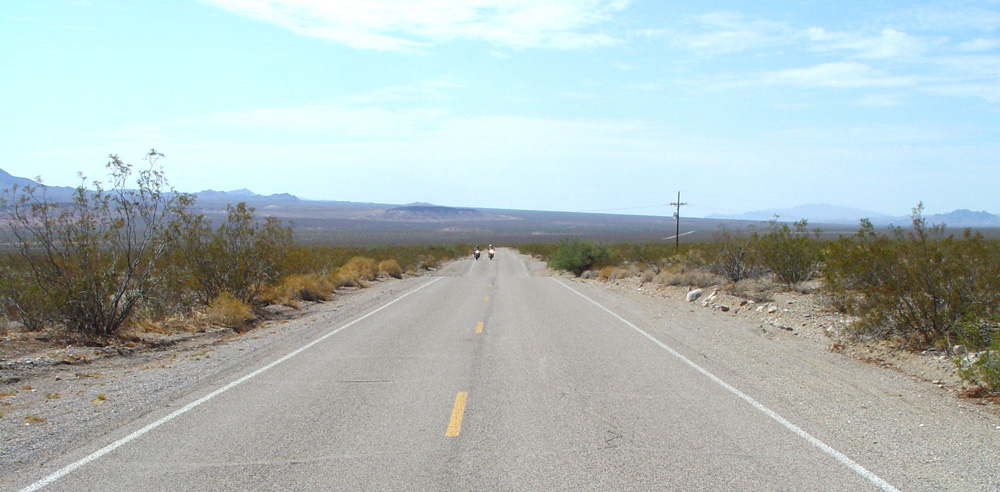
"Doh!" he said, Homer Simpson style.
Then, a beat later, he added, "I bet that's what you said when you hit that deer! Doh!"
I don't mind confessing that by the time I got that awful pun, we were miles down the road, riding in fast formation toward the next little town, where we hoped to find a diner for breakfast. I would have to smack him for it then.
Deerslayer.